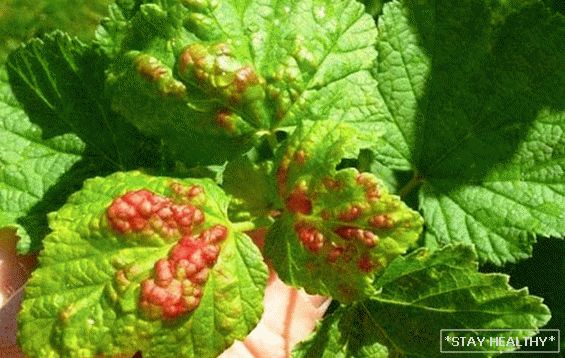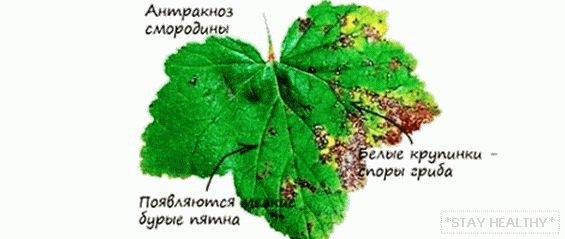 Пт, 05 авг 2016 Автор: Юлия Кривенко
Пт, 05 авг 2016 Автор: Юлия Кривенко
Currant is unstable to various diseases. More often
the shrub undergoes fungal and viral diseases that
reduce the winter hardiness of the plant, yield and lead to
doom
One of these diseases is currant anthracnose. The reasons
the occurrence of the disease? How to recognize the first signs of the disease? Than
to treat currants? All these questions interest the gardener, who
wants to grow a healthy garden.
Contents
What is anthracnose currant
This insidious disease affects the leaves of black currant, and on
red currants suffer petioles, fruits and stems. Anthracnose
currant is a fungal disease that begins to develop
with the onset of warm days, as a rule, in May.
On leaves of currant appear small brown spots,
which gradually merge into one big spot. All infected
leaves fall prematurely, curling upwards. Already in the middle
July, diseased plants lose most of their leaf cover.
Young shoots cease to grow, poorly matured, which reduces
winter hardiness of the plant. In the spring on the affected shrubs a lot of dry
and frozen branches.

The reasons появления болезни
The development of anthracnose on currants favors high
air temperature with moisture. This is possible in the rainy summer,
when the humidity rises. Moisture on the leaves – perfect
medium for germination of fungus.
You can watch currant anthracnose flashes on those areas
where plants suffer from a large number of pests. Insects
can carry the spores of the fungus on the leaves.
In addition, the fungus spreads in strong gusts of wind.
The pathogen overwinters in fallen leaves, if they are not timely
clean up, then with the onset of a comfortable temperature the spores are spread
blown on young shoots.
Currant is practically not damaged in dry summer
anthracnose. As can be seen from the above, most often suffer
unkempt planting currants where it accumulates under plants
a lot of fallen leaves, weeds, and the bush is inhabited by pests.
How to treat anthracnose on currants
Even if the needs had time to mature before the outbreak of the disease, and
gardener managed to harvest, it still does not mean that
the disease passed with little loss. Anthracnose drains
shrub, reducing its winter hardiness. Without proper treatment, already
in a few years, the currant productivity will drop to zero.
It is necessary to begin treatment from early spring, but also after harvesting
can not be idle. In the autumn you need to handle planting 1% solution
Bordeaux mixture. All plant residues must be carefully collected.
and burn.
Important! In the fallen leaves infection
persists until spring! Therefore, after harvesting should be carried out
sanitary cleaning and digging the soil under shrubs.
In the spring struggle with the disease continues. Shrub processing
spend before bud break. For this purpose use 1% solution
copper sulfate. In addition, it is necessary to treat the soil well.
currants to destroy the fungus spores.
Another spraying done before flowering. In that
period apply Topsin-M, adding to it immunostimulating
drugs: Appin, Zircon.
If the disease progresses during harvest, its
need to hold back. To do this, use biological products:
Fitosporin, Gamair.
Important! One of the conditions for successful processing
is thoroughly spraying the underside of the leaves.
When processing currants need to remember that drugs cause
addictive in plants. With each subsequent spraying they will
act less effectively. Therefore it is necessary to alternate regularly and
change drugs to fight the disease. Good results are noticed.
when spraying currant solutions with colloidal sulfur,
homycin.
Increase immunity to plants
Currant anthracnose resistance can only increase in
strong plants with good immunity.
It is possible to increase the immunity of shrubs with the help of fertilizers. For
This is used by various complexes of fertilizing.
1. In early spring, currant watered next
recharge:
• Ammonium nitrate – 1 tbsp. l;
• Iron vitriol – 3 gr;
• Борная кислота — 0,5 ч. l;
• Potassium sulphate – 1 tbsp. l;
• Water – 10 liters.
This solution contributes not only to the growth of green mass,
but also protects the plant from leaf chlorosis, improves immunity.
2. In the period of fruit set, shrubs are fed
mixture with added ash. This feed increases
winter hardiness of culture, promotes fruit ripening, helps
plant to endure drought.
• Superphosphate – 1 tbsp. l;
• Potassium sulphate – 2 tbsp. l;
• Sodium HUMATE – 1 pack;
• Ash – 1 cup;
• Water – 10 liters.
3. For устойчивости смородины к болезням и вредителям
You can spray the leaves as follows.
composition:
• Immunocytophyte – 1 tablet;
• Potassium sulphate – 2 tbsp. l;
• Superphosphate – 1 tbsp. l;
• Water – 10 liters.
Spraying should be carried out in calm weather, wetting
leaves from all sides.
Disease prevention
To not prevent the occurrence of fungal disease on
currant varieties that are less susceptible
поражению anthracnose. Today there are many such species:
1. Plants with high resistance to
disease:
• “Belarusian sweet”;
• «Thanпион»;
• “Zoya”;
• “Dove”.
2. Varieties with an average degree of resistance:
• “Leah is fertile”;
• “Exhibition”;
• “Elegant”.
3. The most vulnerable varieties include all old ones.
разновидности смородины, и сорт «Неаполитанка». Such
plants have a very low yield, painful appearance, weak
winter hardiness Growing them on the plot does not bring the desired
results.
Redcurrant is also affected by anthracnose, even the presence of
a few spots causes great damage to the plant. Most
resistant varieties are: “Dutch Red”, “Victoria”,
�”Firstborn”.
As a disease prevention, you need to comply with all
currant care rules:
1. You need to grow shrubs in a well-lit place that
reduce the risk of various diseases. Lack of light
отрицательно сказывается на currants.
2. Regular spring and autumn sanitary pruning helps
fight the thickening of the bush. Thinning is necessary for
good airing culture.
3. The timely removal of weeds reduces the number of
pests that tolerate fungal spores, lowers moisture
air around the plants. This reduces the risk of fungal
diseases.
4. Proper application of phosphorus-potassium fertilizer increases
Currant immunity and its resistance to diseases.
5. Clearing beds from plant residues helps to get rid of
from pathogens.
The secret of big harvests of currants lies in good care,
timely detection of diseased plants, as well as in
preventive measures and taking urgent measures to treat
shrub.





